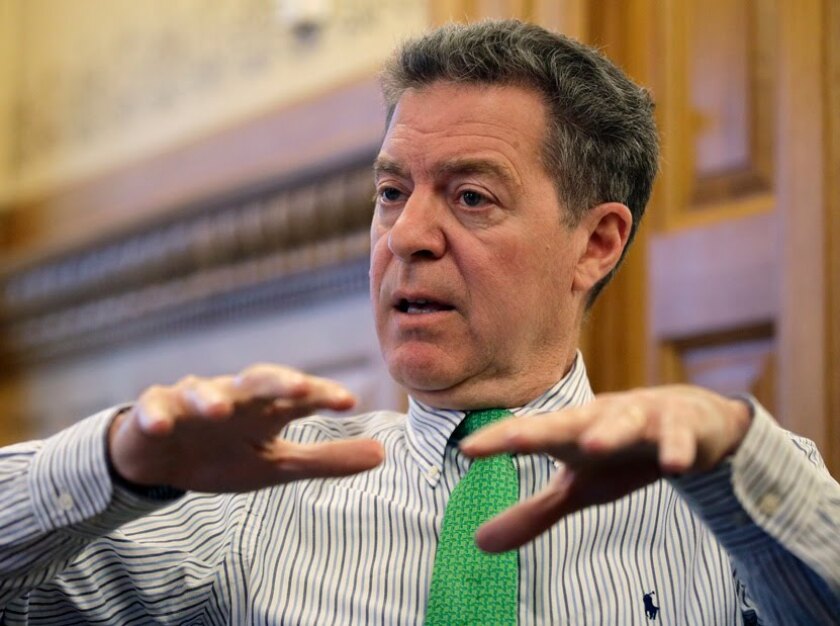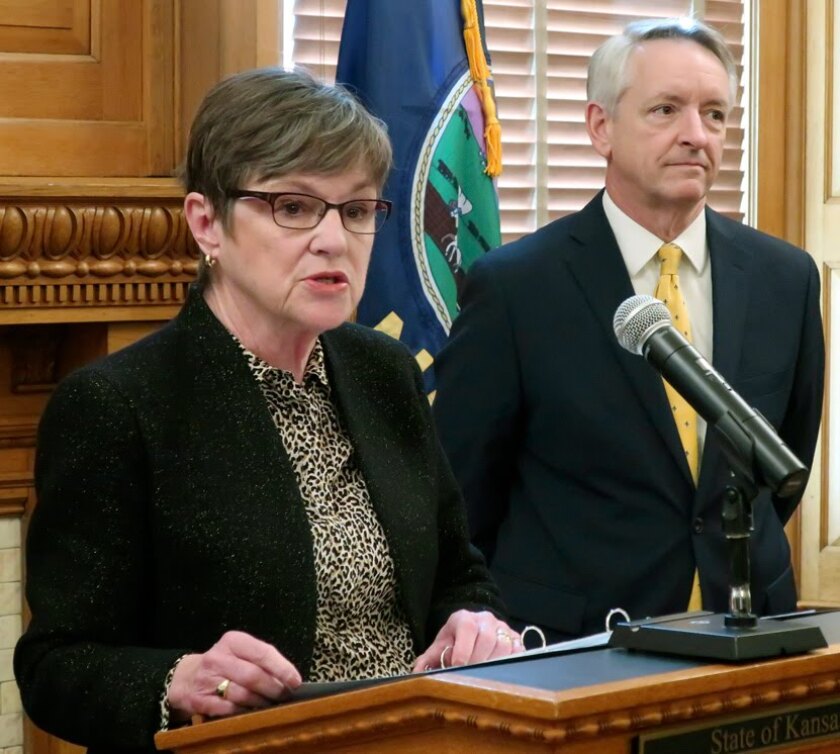The Docking building is an exaggerated but emblematic example of what has happened to Kansas state government in recent years. To students of state politics, the failed Kansas experiment with deep cuts to corporate and income tax rates -- which GOP Gov. Sam Brownback promised would lead to an economic flowering, and which instead led to anemic growth and crippling deficits -- is well known. What is not as well understood, even within Kansas, is the degree to which years of underfunding and neglect have left many state departments and facilities hollowed out. “Washington-style politics and policy really destroyed our state in many ways,” says the current governor, first-year Democrat Laura Kelly. “It bankrupted our state, decimated our agencies. We were not able to provide basic government services.”
All around Kansas government, there are stories about inadequate staffing, from long lines at the DMV to not enough people in the Revenue Department to open, let alone process, tax returns on a timely basis. Kansas’ largest psychiatric hospital had a staff vacancy rate that reached 40 percent and a moratorium on new patient admissions has been in place since 2015. Staff turnover in social services in general and at the state prisons has led to dozens of missing foster children and a series of prison uprisings. “I think there was some hostility just toward the very existence of the agency, frankly,” says David Toland, secretary of the Commerce Department, which saw a 40 percent budget reduction under Brownback. “We are here to do the hard work of rebuilding state government, period.”
The fact that employees were scattered from the Docking building into leased spaces around Topeka was typical. Brownback believed in contracting things out, often with little or no competition. The number of no-bid contracts more than doubled in Kansas over the past five years, to a total of $428 million. “There was more using state dollars to benefit -- I don’t want to say friends, but it looks like there was a fair amount of what I consider corruption,” Kelly says.
Kelly, who is 69 and served in the state Senate for 14 years, never aspired to be governor. “This really was never on my bucket list,” she says while sitting at the long conference table in her office. Kelly was asked repeatedly to run by other Democrats, entering last year’s contest late to bolster a weak field. She ran on a platform of restoring stability and order to state government. It was a message the public was ready to hear. She defeated Kris Kobach, then the secretary of state, by 5 percentage points in a five-person race, taking 48 percent of the vote.
Not all legislators share Kelly’s sense of urgency. Republicans balked at some of her proposals to increase revenues this year. Instead, in a move that seemed bizarre to some Kansans, they tried twice to add new tax cuts, efforts that Kelly vetoed. “We will not be able to unleash the spending to allow the agencies to staff up to the levels they need on corrections officers and social workers and ag inspectors, and it goes on and on,” says Melissa Rooker, a former GOP state representative Kelly appointed to run the Kansas Children’s Cabinet and Trust Fund.

Former Gov. Sam Brownback (AP)
Kelly’s time in office will be defined by the debate about how much and how quickly state government needs repair. “This governor has ratcheted up spending by 9 percent, which will necessitate tax increases in the near future,” says GOP state Sen. Mary Pilcher-Cook. “This is just plain wrong and instead the governor should be budgeting within existing resources.”
Others believe, however, that existing resources may not be enough. Over the past two years, Kansas has suffered four prison “disturbances.” They were more like riots. One building was burned down and there was considerable damage from arson and unrest elsewhere. “The ability to lock down the people who are engaging in violent behavior is severely reduced right now,” says Roger Werholtz, who served as acting corrections secretary until July. “People are cycling through disciplinary segregations. If somebody stabs an officer, we have to kick somebody else out to put them in.”
During the Brownback administration, from 2011 to 2018, prison staff turnover doubled, to more than 40 percent per year, while the prison population increased by 1,400 inmates, or 15 percent. Guards have been burned out by mandatory overtime and by pay scales that have failed to keep pace with increased insurance premiums and copays, let alone inflation. With inadequate and inexperienced staff, the prisons began employing a technique known as “collapsing posts,” meaning some areas were simply left unguarded.
Fixing the problem, Werholtz conceded during budget season, would cost quite a bit of money. Legislators were not happy with his message. They punted most of Kelly’s request for spending to deal with prison overcrowding to the State Finance Council, which in June blocked nearly $10 million. “It’s time to pay the bill,” Werholtz says, “and I don’t know if anybody’s got the stomach to pay for it.”
There were other holes legislators were willing to plug. Under Brownback, more than $2 billion was shifted out of Kansas Department of Transportation trust funds, earning the agency the nickname “Bank of KDOT.” Lawmakers had already been at work on a plan to address transportation shortfalls by the time Kelly unveiled her proposal to slowly end budget transfers from the trust funds over a four-year period. The legislature this year also approved a package of bills to address problems at the Department of Children and Families, including an increase in funding to hire dozens of additional social workers. “I do think some of the agencies did get hollowed out,” says Jim Denning, the Republican Senate majority leader. “The economy was awful and Brownback’s tax policy, I think everybody will agree, went too deep, too quickly.”
The legislature had a legal gun to its head when it came to school funding. School finance has been an ongoing nightmare for the state for decades, with the state Supreme Court finding that expenditures have not been adequate. Lawmakers approved an additional $485 million in 2017, but the court said they’d failed to take inflation into account. This year, the legislators signed off on an additional $90 million annual increase. “This was a layup year for Gov. Kelly,” Denning says, “because the senior Republican leadership had the same agenda that she had on lots of things, like K-12 funding and restoring KDOT funding.”
But they certainly didn’t see eye to eye on everything. Five rural hospitals have closed, but legislative leaders refused to expand Medicaid, which was a top priority for the governor. A Medicaid expansion bill passed the House, but was blocked by Senate leaders, even though it was backed by a majority of senators. The legislature also killed Kelly’s plan to refinance state employee pensions, which would have freed up $770 million over the next five years, but would have cost the state nearly 10 times that amount over three decades. Kelly opposed and vetoed a separate Republican plan to pump $51 million into the pension system. GOP legislators called that decision irrational. Kelly wants to expand programs with a credit card, says Republican state Sen. Molly Baumgardner.
Baumgardner notes that the number of missing kids didn’t go down during the governor’s first few months in office and complains that half of the 2,000 people that school districts have hired back aren’t teachers or counselors. Every new tax dollar seems destined for education anyway, Baumgardner says. K-12 schools, colleges and universities combine to absorb 60 percent of the state budget. Getting education spending back as high as it was a decade ago, adjusted for inflation, is expected to take four more years. “There’s a reason some of these agencies are being hollowed out,” Baumgardner says, “and that’s K-12.”

Gov. Laura Kelly, left (AP)
Kansas hasn’t sent a Democrat to the U.S. Senate since 1932 and hasn’t supported a Democratic presidential candidate since Lyndon B. Johnson. President Trump carried the state by 20 points in 2016. Still, while Kansas is unquestionably a red state, politics is a more competitive game than it may seem from the outside. As a Democratic governor, Kelly is no fluke. Control of her office has switched back and forth between the parties consistently ever since the 1950s, usually every eight years but sometimes every four. “Laura Kelly, as a relatively moderate Democrat, is a return to this trend of centrists from both parties being governor,” says Patrick Miller, a University of Kansas political scientist.
In some ways, Kelly is a surprising champion. She is clearly liberal on issues such as abortion and gay rights, but having represented a largely Republican Senate district in the eastern part of the state, she’s always been a pragmatist ready to cut whatever deal she could with her majority Republican colleagues. Kelly is a short woman with a dry sense of humor, who is measured and cautious about what she says. A military kid, she grew up on the East Coast before spending a long career working with troubled children in hospitals, a psychiatric facility and therapeutic camps, then running the Kansas Park and Recreation Association prior to entering the Senate. She’s not the type of politician who ever goes ballistic. Her staff can tell when she’s upset by the way she arches an eyebrow or starts to curl her lip. “When she’s not happy, you’ll know it,” says Lt. Gov. Lynn Rogers, “but she doesn’t feel she has to shout it from the rooftops.”
No one denies Kelly’s earnestness about the business of state government and readiness to dive into the details of its finances. Unlike the vast majority of politicians, she says she actually misses the committee hearings she sat through in the Senate. “Over on that table, I have the spreadsheets from the Ways and Means conference committee,” Kelly says in her office. “I go through it line by line. In fact, the most fun I’ve had as governor was during the transition phase, when I spent 10 days across the street in the Landon state office building with my budget people in a windowless room, going through the budget line item by line item.”
She didn’t like what she saw, though she already knew there were problems. While she was still a senator in 2017, she said she was “flabbergasted” when the secretary of the Department of Children and Families admitted to being unaware of three sisters who had been missing from foster care for 45 days. They were among more than 70 missing children who were in DCF care.
Under the previous administration, employees who were denied raises were sometimes told they could get them if they were willing to give up their civil service protections (which in Kansas are called classified status). As a result, two-thirds of state jobs are now unclassified. It became “standard operating procedure” for state workers to try to hunker down and not to attract attention to themselves or what they were doing, says Rooker, the former legislator who runs the children’s cabinet. Even prison wardens were warned they’d get fired if they talked amongst themselves, let alone warn legislators or reporters about problems.
To employ a Kansas metaphor, members of Kelly’s administration compare the Brownback years to a tornado. Many state employees fled. Either their positions were cut, or living without raises became a burden after the second or third year. Some of those who stuck around felt the missions of their agencies weren’t supported by the administration. “Sam Brownback seemed not to care about the management part of his job,” says Miller, the Kansas University professor. “There was no regard, at times, for how these agencies were running. His mission was to shrink government.”
By the time Kelly took office, legislators recognized the hole the state was in. Coming hard on the heels of the recession, state revenues plunged $700 million during the first year following Brownback’s tax cuts. Missing revenue targets became a monthly sport in Kansas for years after. With schools shutting down early and Brownback looking to raid funding for other children’s programs, the Republican-controlled legislature finally rolled back most of Brownback’s tax cuts in 2017, over his veto. (Brownback left office last year to become an ambassador. His replacement, Jeff Colyer, was narrowly defeated by Kobach in the Republican primary.)

Senate Majority Leader Jim Denning (David Kidd)
Largely as a result of the 2017 rollback of Brownback’s program, Kansas tax receipts are now expected to exceed $7 billion annually through 2022, which would be a record. Given the improved fiscal situation, Republican leaders seem unwilling to answer Kelly’s call to address a crisis in state government, or even trust her claim that there is one. “We fixed the major policy areas that were weakened under Brownback,” Denning says. “Now, she’s in a glass house and we’re going to see what kind of governor she is going forward.”
Many conservative legislators have never known life under a Democratic governor. Some continue to claim that her election was illegitimate or at least tainted by the fact that she won less than a majority against Kobach. He was not only a lightning rod due to his militant anti-immigration and voter-fraud crusades, but ran a poor race, making appearances on television and driving around in a pickup truck while establishing virtually no campaign operation.
Kathleen Sebelius, the last Democrat elected Kansas governor, frequently fought with the Republican legislature of her day, but she had moderate GOP leaders she could cut deals with. By contrast, Denning and Senate President Susan Wagle, along with their counterparts in the House, Speaker Ron Ryckman and Majority Leader Dan Hawkins, all belong to the more confrontational conservative wing of the party. Wagle is running for the U.S. Senate next year, increasing her reluctance to give Kelly anything that looks like a win on things such as Medicaid expansion. “There is no doubt,” Kelly says, “that there are some who are not interested in negotiating.” GOP leaders, in turn, complain that Kelly barely bothered to meet with them this year, let alone seek their input on legislation.
The overall partisan numbers in the Kansas House didn’t change last year. The Senate remained the same because its seats weren’t up in 2018. Still, the legislature moved to the right overall. Conservative pressure groups, which have targeted and taken out moderate incumbents in Republican primaries in the past, ran negative ads against them in the fall. They figured their votes on policy wouldn’t be that different from those of Democrats anyway, and they were probably right: Three moderate Republican legislators switched to the Democratic party after the election. The end result was fewer moderate votes in GOP leadership contests. “What you ended up with was a more robust right-wing majority,” says Rooker, a centrist Republican who was targeted by the conservative Americans for Prosperity and lost her seat last November.
Kelly now is hoping that the 2020 election will result in the tide turning yet again in the three-way swirl of Kansas partisan politics, giving her a Democratic-moderate Republican coalition to support her effort to revive state government. She knows it will take a multiyear effort and that she’ll need all the help she can get. “I sort of knew what this was going to be about,” Kelly says of the job in front of her. Then, with a laugh, she adds, “Which is probably one of the reasons I didn’t want to run for it.”









